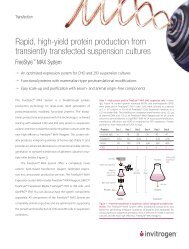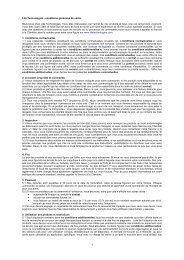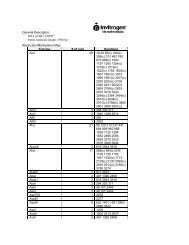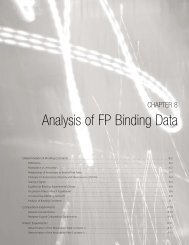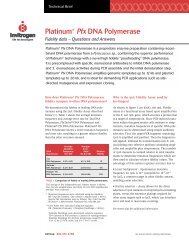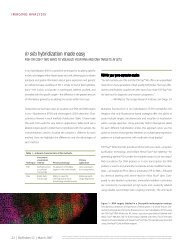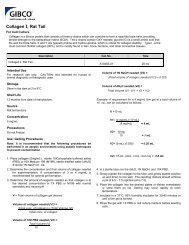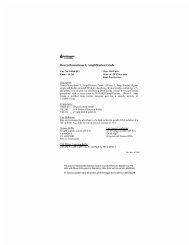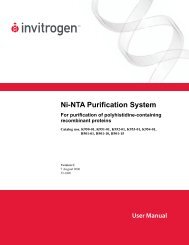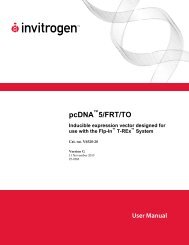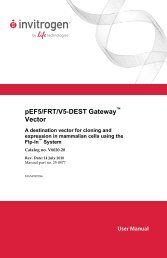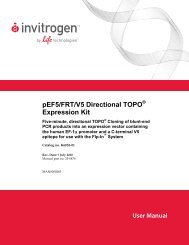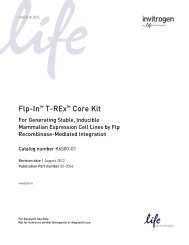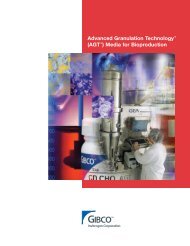Cell-based tools for interrogating the pI3K/Akt/mTor pathway
Cell-based tools for interrogating the pI3K/Akt/mTor pathway
Cell-based tools for interrogating the pI3K/Akt/mTor pathway
Create successful ePaper yourself
Turn your PDF publications into a flip-book with our unique Google optimized e-Paper software.
<strong>Cell</strong>-<strong>based</strong> <strong>tools</strong> <strong>for</strong> <strong>interrogating</strong> <strong>the</strong> <strong>pI3K</strong>/<strong>Akt</strong>/<strong>mTor</strong> <strong>pathway</strong><br />
CELLSENSOR ® AND LANTHASCREEN GFp CELLULAR ASSAYS.<br />
The PI3K/<strong>Akt</strong> signaling <strong>pathway</strong> is central to cell growth and survival,<br />
entry into <strong>the</strong> cell cycle, and regulated cell death (Figure 1). Aberrant acti-<br />
vation of this signaling cascade is linked to diseases including cancer, dia-<br />
betes, cardiovascular conditions, and neurological disorders. 1 Moreover,<br />
compounds that target this network (e.g., rapamycin and its analogs)<br />
have proven efficacious as approved drugs targeting such diverse indi-<br />
cations as renal cell carcinoma, transplant rejection, and <strong>the</strong> prevention<br />
of restenosis following balloon angioplasty. These observations make<br />
numerous components of <strong>the</strong> <strong>pathway</strong> attractive as <strong>the</strong>rapeutic targets,<br />
and have fueled drug discovery and high-throughput screening (HTS)<br />
ef<strong>for</strong>ts in this area. The considerable degree of complexity, crosstalk, and<br />
feedback regulation that exists within <strong>the</strong> PI3K/<strong>Akt</strong> <strong>pathway</strong>—especially<br />
as applied to <strong>the</strong> regulation of <strong>the</strong> mammalian target of rapamycin<br />
(mTOR) and its complexes (mTORC1 and mTORC2)—underscores <strong>the</strong><br />
need <strong>for</strong> cell-<strong>based</strong> methods to properly identify and characterize<br />
small-molecule modulators of <strong>the</strong> <strong>pathway</strong>. Because cellular intricacies<br />
Cytoskeletal<br />
reorganization<br />
Rapamycin<br />
FKBP<br />
<strong>Cell</strong> growth<br />
4E-BP1<br />
eIF4E<br />
P<br />
+P<br />
mTORC2<br />
GβL m T O R rictor<br />
mTORC1<br />
GβL m T O R raptor<br />
+P<br />
Rheb<br />
TSC2<br />
TSC1<br />
+P<br />
PDCD4<br />
eIF4B<br />
P<br />
RPS6<br />
eIF4A<br />
Translation<br />
initiation<br />
P<br />
+P<br />
SK6<br />
P<br />
eIF2B<br />
P<br />
P<br />
PRAS40<br />
+P<br />
+P<br />
+P<br />
Glycogen<br />
syn<strong>the</strong>sis<br />
GSK-3β<br />
+P<br />
+P<br />
+P<br />
β-CTN<br />
PP2A<br />
α4<br />
P<br />
+P<br />
Transcription<br />
P<br />
+P<br />
-P<br />
CCND1<br />
NFAT<br />
P<br />
PDK1<br />
AKT<br />
p21<br />
p27<br />
<strong>Cell</strong> cycle<br />
P<br />
+P<br />
+P<br />
P<br />
P<br />
P +P<br />
IkB<br />
PIP3 PIP2<br />
-P<br />
PTEN<br />
+P<br />
IKK<br />
+P +P<br />
GATA4 NFAT NFκB<br />
P<br />
+P<br />
+P<br />
+P<br />
IκB<br />
NFκB<br />
© 2008 Invitrogen Corporation. All rights reserved. These products may be covered by one or more Limited Use Label Licenses (see Invitrogen catalog or www.invitrogen.com). By use of <strong>the</strong>se products<br />
you accept <strong>the</strong> terms and conditions of all applicable Limited Use Label Licenses. For research use only. Not intended <strong>for</strong> any animal or human <strong>the</strong>rapeutic or diagnostic use, unless o<strong>the</strong>rwise stated.<br />
+P<br />
+P<br />
P<br />
+P<br />
Mdm2<br />
F OXO<br />
P<br />
ASK-1<br />
P<br />
P<br />
F OXO<br />
Growth factor<br />
P<br />
BAD<br />
CASP9<br />
p53<br />
p85 p110<br />
PI3K<br />
AR<br />
FAS-L<br />
p27<br />
KIP1<br />
<strong>Cell</strong> proliferation<br />
P<br />
P<br />
P<br />
p53<br />
RTK<br />
Apoptosis<br />
p21<br />
F A S<br />
PTEN<br />
CIP1<br />
are lost when using purified components in a biochemical experiment,<br />
Invitrogen is introducing a more holistic approach to <strong>pathway</strong> analysis.<br />
Two cell-<strong>based</strong> <strong>tools</strong>, both HTS-compatible and fluorescence-<strong>based</strong>,<br />
have been developed to interrogate <strong>the</strong> PI3K/<strong>Akt</strong>/<strong>mTor</strong> <strong>pathway</strong>: (1) a<br />
traditional <strong>Cell</strong>Sensor® reporter gene–<strong>based</strong> system that provides an<br />
endpoint measurement of global compound effects on <strong>the</strong> PI3K/<strong>Akt</strong>/<br />
Foxo3 arm of <strong>the</strong> <strong>pathway</strong>, and (2) a LanthaScreen GFP cellular assay<br />
<strong>for</strong>mat that enables detection of changes in <strong>the</strong> phosphorylation status<br />
of specific kinase targets within <strong>the</strong> <strong>pathway</strong>, including readouts <strong>for</strong> both<br />
mTORC1 and mTORC2 activity.<br />
<strong>Cell</strong>Sensor® products<br />
Invitrogen has extensive experience developing <strong>Cell</strong>Sensor® cell lines<br />
that use GeneBLAzer® technology to provide a reliable, rapid, and sensi-<br />
tive method <strong>for</strong> analyzing <strong>the</strong> response of disease-relevant signal<br />
Figure 1—<strong>the</strong> <strong>Akt</strong> signaling <strong>pathway</strong>. This cell signaling cascade is<br />
involved in numerous biological processes, including <strong>the</strong> regulation of<br />
metabolism, cell growth and survival, cell-cycle progression, and transcription<br />
and translation. AKT resides downstream of phosphoinositide 3-kinase<br />
(PI3K) signaling, which is activated upon binding of growth factors (e.g.,<br />
insulin) to receptor tyrosine kinases (RTKs) on <strong>the</strong> cell surface. Activated<br />
AKT phosphorylates a range of substrates, including PRAS40 and FOXO3.<br />
The mammalian target of rapamycin (mTOR) is a serine/threonine kinase<br />
that assembles into two distinct complexes inside <strong>the</strong> cell (mTORC1 and<br />
mTORC2) and has been placed on both sides of <strong>the</strong> <strong>Akt</strong> signaling hub.<br />
mTORC1 (<strong>the</strong> rapamycin-sensitive complex with raptor) resides downstream<br />
of AKT, while mTORC2 (<strong>the</strong> rapamycin-insensitive complex with<br />
rictor) is able to fully activate AKT by direct phosphorylation at Ser473.<br />
www.invitrogen.com | 17
PrACtICAL APPLICAtIONS<br />
A B<br />
C<br />
460 nm/530 nm<br />
low [ FOXO3 ]<br />
(green cells)<br />
1.60<br />
1.40<br />
1.20<br />
1.00<br />
0.80<br />
0.60<br />
0.40<br />
0.20<br />
– Insulin<br />
+ Insulin<br />
Figure 2—<strong>Cell</strong>Sensor® reporter gene readout <strong>for</strong> PI3K/<strong>Akt</strong> <strong>pathway</strong> analysis. (A) The T-REx FOXO3 DBE-bla HeLa cell line (Cat. no. K1468) has a FOXO3<br />
response element (driving beta-lactamase (BLA) expression (DBE-bla)), tetracycline repressor, and tetracycline-inducible Foxo3 constructs. Addition of doxycycline<br />
(DOX, a tetracycline analog) upregulates FOXO3-driven BLA expression. Activation of <strong>the</strong> endogenous PI3K/<strong>Akt</strong> signaling cascade with insulin (Cat.<br />
no. 12585-014) leads to phosphorylation/inactivation of FOXO3 and concomitant suppression of BLA. Interruption of <strong>the</strong> <strong>pathway</strong> with inhibitors restores<br />
FOXO3 transcriptional activity and thus BLA expression (green to blue cells). (B, top) The cellular response to growth factor stimulation was tested with IGF-1<br />
and insulin, and <strong>the</strong> EC 50 values obtained were 1.6 nM and 5 nM, respectively. (B, bottom) The small-molecule inhibitors PI-103 and PI3Kα inhibitor IV were<br />
evaluated, and <strong>the</strong> IC 50 values obtained were 110 nM and 330 nM, respectively. (C) RNAi knockdown experiments of FOXO3 and AKT <strong>for</strong> target validation<br />
were per<strong>for</strong>med. <strong>Cell</strong>s were reverse-transfected with Lipofectamine RNAiMAX (Cat. no. 13778-075) and 20 nM of a panel of RNAi duplexes, including <strong>the</strong><br />
FOXO3 Validated Stealth RNAi DuoPak (Cat. no. 12937-07), <strong>the</strong> AKT1 Validated Stealth RNAi DuoPak (Cat. no. 12935-001), Stealth RNAi oligonucleotides<br />
against beta-lactamase, and <strong>the</strong> medium GC control from <strong>the</strong> Stealth RNAi Negative Control Kit (Cat. no. 12935-100).<br />
transduction <strong>pathway</strong>s upon exposure to drug candidates or o<strong>the</strong>r stim-<br />
uli. 2 The growing portfolio of cell-<strong>based</strong> beta-lactamase reporter assays<br />
addresses (as part of <strong>the</strong> SelectScreen cell-<strong>based</strong> profiling service) more<br />
than 20 different signaling <strong>pathway</strong>s, as well as specific protein targets<br />
(e.g., kinases) that are involved in <strong>the</strong> endogenous <strong>pathway</strong>s.<br />
To build a PI3K/<strong>Akt</strong> <strong>pathway</strong>–specific <strong>Cell</strong>Sensor® cell line, we stably<br />
engineered <strong>the</strong> beta-lactamase reporter under <strong>the</strong> control of a FOXO3<br />
response element (DBE-bla) into HeLa cervical cancer cells. Additionally,<br />
we fur<strong>the</strong>r designed this cell line to feature tetracycline-inducible FOXO3<br />
expression (via <strong>the</strong> T-REx mechanism), because overexpression of FOXO3<br />
is capable of triggering apoptosis through transcription of cell death<br />
genes (e.g., FAS-L), and precise regulation of FOXO3 levels was <strong>the</strong>re<strong>for</strong>e<br />
necessary. When cells are left untreated and <strong>the</strong>n loaded with LiveBLAzer<br />
substrate, <strong>the</strong> FRET-<strong>based</strong> beta-lactamase substrate remains green (no BLA<br />
present) (Figure 2A). Expression of BLA (induced by tetracycline and driven<br />
by FOXO3), however, results in cleavage of <strong>the</strong> fluorescent substrate mol-<br />
ecule, disrupting <strong>the</strong> energy transfer, and cells turn blue. Activation of PI3K<br />
signaling upon growth factor binding (e.g., insulin or IGF-1; Figure 2B) to a<br />
cell-surface receptor tyrosine kinase leads to increased downstream activity<br />
18 | BioProbes 56 | June 2008<br />
[ FOXO3 ]<br />
(blue cells)<br />
+ DOX + insulin<br />
FOXO3–<br />
(green cells)<br />
<strong>pathway</strong> inhibitor (e.g., PI-103)<br />
RNAi against AKT1<br />
enhances -lac readout<br />
RNAi against FOXO3<br />
diminishes -lac readout<br />
0<br />
no Tfxn mock neg -lac FOXO3 FOXO3<br />
control<br />
#1 #2<br />
AKT1<br />
#1<br />
AKT1<br />
#2<br />
Blue/green ratio (460 nm/530 nm)<br />
Blue/green ratio (460 nm/530 nm)<br />
1.50<br />
1.25<br />
1.00<br />
0.75<br />
0.50<br />
0.25<br />
10<br />
[Agonist] (nM)<br />
–1 100 10 –2 101 102 103 0<br />
1.0<br />
0.9<br />
0.8<br />
0.7<br />
0.6<br />
0.5<br />
0.4<br />
0.3<br />
PI3K inhibitor IV<br />
PI-103<br />
10<br />
[Compound] (nM)<br />
0 101 10 –1 102 103 104 0.2<br />
of AKT and subsequent phosphorylation of <strong>the</strong> FOXO3 transcription factor<br />
(among o<strong>the</strong>r targets) to promote cell survival and oppose apoptosis. This<br />
modification at Thr32 inactivates FOXO3, leading to its translocation out of<br />
<strong>the</strong> nucleus and concomitant suppression of BLA expression to yield green<br />
cells. Application of <strong>pathway</strong> inhibitors (e.g., PI-103 or PI3Kα Inhibitor IV;<br />
Figure 2B) or Stealth RNAi (e.g., against AKT1; Figure 2C) restores FOXO3<br />
activity and BLA expression, turning <strong>the</strong> cells back to blue.<br />
Advantages of <strong>the</strong> <strong>Cell</strong>Sensor® assay system include <strong>the</strong> use of a<br />
sensitive fluorescent reporter readout that is amenable to low-volume<br />
HTS <strong>for</strong>mats, ratiometric FRET-<strong>based</strong> data analysis that improves data<br />
quality, and a live-cell signal (blue/green cells) that is highly suitable<br />
<strong>for</strong> microscopic imaging and cell sorting. The T-REx FOXO3 DBE-bla<br />
HeLa cell line provides an effective endpoint readout of PI3K/<strong>Akt</strong>/<br />
Foxo3 <strong>pathway</strong> alteration upon exposure to a variety of ligands.<br />
LanthaScreen GFP cellular assays<br />
LanthaScreen assays use a technology <strong>based</strong> on time-resolved FRET<br />
(TR-FRET) to monitor phosphorylation of a specific kinase substrate in<br />
© 2008 Invitrogen Corporation. All rights reserved. These products may be covered by one or more Limited Use Label Licenses (see Invitrogen catalog or www.invitrogen.com). By use of <strong>the</strong>se products<br />
you accept <strong>the</strong> terms and conditions of all applicable Limited Use Label Licenses. For research use only. Not intended <strong>for</strong> any animal or human <strong>the</strong>rapeutic or diagnostic use, unless o<strong>the</strong>rwise stated.<br />
Insulin<br />
IGF-1
Figure 3—LanthaScreen GFP cellular assay schematic. <strong>Cell</strong>s stably expressing a GFP-fusion of <strong>the</strong> kinase target are stimulated to activate <strong>the</strong> <strong>pathway</strong> and<br />
<strong>the</strong> substrate is phosphorylated (step 1; “in vivo kinase assay”). Next, <strong>the</strong> cells are lysed and a Tb-labeled PSSA is added (step 2). The FRET signal is measured<br />
(step 3) on a fluorescence plate reader in a time-resolved manner.<br />
an endogenous signaling <strong>pathway</strong>. 3 By stably expressing <strong>the</strong> protein<br />
of interest as a fusion with green fluorescent protein (GFP), cells can be<br />
treated with an agonist (e.g., insulin or IGF-1) to stimulate <strong>the</strong> <strong>pathway</strong><br />
and phosphorylate <strong>the</strong> kinase target. Following cell lysis, <strong>the</strong> modifi-<br />
cation is quantitatively detected by a phosphorylation site–specific<br />
antibody (PSSA) that is labeled with terbium (Tb) chelate, which serves<br />
as <strong>the</strong> FRET donor partner (Figure 3). Due to <strong>the</strong> long emission lifetime<br />
of <strong>the</strong> Tb donor, <strong>the</strong> FRET signal can be measured after interference<br />
from autofluorescent molecules or from scattered light has decayed. By<br />
translating <strong>the</strong> LanthaScreen technology into a cellular <strong>for</strong>mat with<br />
GFP-fusion substrates, we have preserved <strong>the</strong> physiological complexity<br />
of live cells to assay <strong>the</strong> endogenous protein kinase within <strong>the</strong> context<br />
of <strong>the</strong> native signaling <strong>pathway</strong>. The robust, homogeneous (no-wash)<br />
<strong>for</strong>mat of <strong>the</strong> LanthaScreen GFP cellular assay offers an attractive<br />
alternative to complex image-<strong>based</strong> assays or traditional methods<br />
such as western blots or ELISAs. There is little hands-on time with this<br />
assay, and it is amenable to automation. Moreover, <strong>the</strong> use of a single<br />
A<br />
1<br />
© 2008 Invitrogen Corporation. All rights reserved. These products may be covered by one or more Limited Use Label Licenses (see Invitrogen catalog or www.invitrogen.com). By use of <strong>the</strong>se products<br />
you accept <strong>the</strong> terms and conditions of all applicable Limited Use Label Licenses. For research use only. Not intended <strong>for</strong> any animal or human <strong>the</strong>rapeutic or diagnostic use, unless o<strong>the</strong>rwise stated.<br />
2<br />
antibody simplifies <strong>the</strong> assay and improves per<strong>for</strong>mance relative to<br />
o<strong>the</strong>r two-antibody “sandwich” approaches.<br />
To interrogate <strong>the</strong> PI3K/<strong>Akt</strong> <strong>pathway</strong> using <strong>the</strong> LanthaScreen GFP<br />
cellular assay technology, specifically as it applies to <strong>the</strong> regulation of<br />
mTOR, we have generated three different cell lines, each with a GFP<br />
fusion of a key <strong>pathway</strong> marker: PRAS40, PDCD4, and AKT (Figure 4A).<br />
Importantly, each of <strong>the</strong>se assays are built in a HEK 293E cell back-<br />
ground, where (unlike HEK 293T cells), <strong>the</strong> mTOR <strong>pathway</strong> is strongly<br />
regulated by serum and insulin. 4<br />
0.20<br />
0.055<br />
B C D<br />
0.100<br />
Emission ratio<br />
0.16<br />
0.12<br />
0.08<br />
0.04<br />
PI-103<br />
Rapamycin<br />
[Inhibitor] (nM)<br />
PI3K<br />
AKT<br />
P<br />
GFP PRAS40<br />
0<br />
0.0001 0.001 0.01 0.1 1 10 100 1,000 10,000<br />
Emission ratio<br />
0.085<br />
0.070<br />
0.055<br />
0.040<br />
P<br />
PI-103<br />
Rapamycin<br />
raptor mTOR<br />
GFP<br />
P<br />
PDCD4<br />
0.025<br />
0.00001 0.0001 0.001 0.01 0.1 1 10 100 1,000 10,000<br />
[Inhibitor] (nM)<br />
P<br />
Tb<br />
A cell line to monitor immediately downstream of <strong>Akt</strong> was gener-<br />
ated that contains a GFP fusion of <strong>the</strong> 40 kDa, proline-rich AKT substrate<br />
of PRAS40. This protein is phosphorylated at Thr246 by AKT in response<br />
to insulin. This modification of PRAS40 is known to promote interaction<br />
with 14-3-3 adaptor proteins, leading to its dissociation from mTORC1<br />
and subsequent inactivation. Consequently, mTORC1 activity and down-<br />
stream signaling is restored. 3 Because AKT phosphorylation of PRAS40<br />
is upstream of mTOR, it is affected by PI3K inhibitors (e.g., PI-103,<br />
3<br />
[Inhibitor] (nM)<br />
TR-FRET<br />
Figure 4—Assessing compound action on <strong>the</strong> PI3K/<strong>Akt</strong>/mtor signaling <strong>pathway</strong>. (A) GFP fusions of key <strong>pathway</strong> markers enable dissection of signaling<br />
complexity. Comparison of small-molecule inhibitor titrations against (B) LanthaScreen PRAS40 (Cat. no. K1528), (C) LanthaScreen PDCD4 (Cat.<br />
no. K1593), and (D) LanthaScreen AKT (Cat. no. K1615), all in HEK 293E cells. PI-103 (a dual PI3K and mTOR inhibitor) has global effects on <strong>the</strong> <strong>pathway</strong><br />
and shows activity in each assay readout (IC 50 values ~100 nM). Rapamycin (Cat. no. PHZ1233), however, only inhibits <strong>the</strong> phosphorylation of PDCD4<br />
(IC 50
PrACtICAL APPLICAtIONS<br />
160<br />
110<br />
80<br />
Figure 5—Validation of LanthaScreen and <strong>Cell</strong>Sensor® cell lines via western blot. (A) LanthaScreen GFP-AKT HEK 293E cells were treated under <strong>the</strong><br />
indicated conditions, including IGF-1 (Cat. no. PHG9071), LY294002 (Cat. no. PHZ1144), and wortmannin (Cat. no. PHZ1301). <strong>Cell</strong> extracts were resolved by<br />
SDS-PAGE and transferred to nitrocellulose with <strong>the</strong> iBlot® Gel Transfer Device (Cat. no. IB1001). The membrane was <strong>the</strong>n probed with <strong>the</strong> anti-AKT [PS473] PSSA<br />
(Cat. no. 44-621G), and <strong>the</strong> signal was detected using a WesternBreeze® Chromogenic Kit (Cat. no. WB7105). (B) <strong>Cell</strong>Sensor® T-REx FOXO3 DBE-bla HeLa cell<br />
lysates were generated by treatment with doxycycline to induce FOXO3 expression, followed by incubation with <strong>the</strong> indicated stimulants or inhibitors and lysis.<br />
The nitrocellulose membrane was prepared and developed as in (A), except that <strong>the</strong> PSSA used in this case was anti-FOXO3 [PT32] (Cat. no. 44-1240G).<br />
LY294002, and wortmannin) but is insensitive to rapamycin (Figure 4B).<br />
Interestingly, <strong>the</strong> mTOR kinase is able to phosphorylate PRAS40 directly<br />
at Ser183 in a rapamycin-sensitive manner, which fur<strong>the</strong>r complicates<br />
<strong>the</strong> role of this protein within <strong>the</strong> <strong>mTor</strong> <strong>pathway</strong>.<br />
To monitor <strong>pathway</strong> activation downstream of <strong>the</strong> mTORC1<br />
complex, a cell line was developed that contains a GFP fusion of<br />
programmed cell death protein 4 (PDCD4). This protein is a tumor<br />
suppressor that inhibits translation initiation by binding to eIF4A. In<br />
response to insulin stimulation, PDCD4 is phosphorylated by p70 S6<br />
kinase (at Ser457), which is immediately downstream of (and activated<br />
by) mTORC1. This phosphorylation event marks PDCD4 <strong>for</strong> SCF βTRCP -<br />
mediated ubiquitination and subsequent degradation. 6 Inactivation<br />
of PDCD4 is necessary <strong>for</strong> efficient protein syn<strong>the</strong>sis, and ultimately<br />
<strong>for</strong> cell growth and proliferation. Because PDCD4 is part of <strong>the</strong> PI3K/<br />
<strong>Akt</strong> <strong>pathway</strong> and is linked to mTORC1 activity, its phosphorylation is<br />
sensitive to both PI-103 and rapamycin (Figure 4C).<br />
To examine <strong>pathway</strong> activation downstream of <strong>the</strong> multiprotein<br />
mTOR complex with rictor (mTORC2), a cell line containing a GFP<br />
fusion of AKT was constructed. Also known as protein kinase B (PKB),<br />
AKT has emerged as one of <strong>the</strong> most important and most actively<br />
studied kinases due to its versatility in regulating protein function<br />
and influencing human disease. Although AKT is often placed at <strong>the</strong><br />
“beginning” of <strong>the</strong> <strong>pathway</strong>, it has also been shown to be a substrate<br />
of mTORC2, which phosphorylates AKT at Ser473. 7 This modification is<br />
required <strong>for</strong> full activation of AKT, and it leads to <strong>the</strong> repression of pro-<br />
apoptotic events. The precise mechanism and consequences of Ser473<br />
phosphorylation remain controversial, yet this site has been shown to<br />
be insensitive to acute treatment with rapamycin (Figure 4D).<br />
20 | BioProbes 56 | June 2008<br />
60<br />
50<br />
MW<br />
Untreated<br />
+ Insulin<br />
+ Wortmannin<br />
+ LY290042<br />
+ Rapamycin<br />
A B<br />
GFP–AKT P<br />
AKT P<br />
115<br />
82<br />
+ PI-103<br />
+ LY290042<br />
The future of PI3K/<strong>Akt</strong>/<strong>mTor</strong> <strong>pathway</strong> analysis<br />
Each of <strong>the</strong> cell lines described here is a clonal population isolated by<br />
flow cytometry. The corresponding HTS assays have been optimized<br />
in 384-well <strong>for</strong>mat by testing a variety of parameters (e.g., DMSO<br />
tolerance, cell number, and stimulation time) and provide excellent<br />
statistical data (Z´-factor ≥0.5). Additionally, we have validation data<br />
<strong>for</strong> several known agonists and commercially available ligands, and<br />
<strong>the</strong> observed pharmacology (EC 50 or IC 50 values) is in agreement<br />
with reported literature data. Most importantly, we have compared<br />
<strong>the</strong>se data to those obtained using alternative technologies from<br />
Invitrogen (e.g., western blotting with PSSA (Figure 5); phosphoELISA<br />
and Mercator Phospho-AKT Pathway Array; data not shown), with<br />
excellent correlation seen. Taken toge<strong>the</strong>r, <strong>the</strong>se cell lines constitute<br />
a validated set of <strong>tools</strong> <strong>for</strong> studying a complex <strong>pathway</strong> in a simpli-<br />
fied <strong>for</strong>mat that complement our existing biochemical assays. These<br />
cell-<strong>based</strong> assays will facilitate <strong>the</strong> identification of novel modulators<br />
of PI3K/<strong>Akt</strong>/<strong>mTor</strong> signaling. Learn more about <strong>Akt</strong> <strong>pathway</strong>–related<br />
products at www.invitrogen.com/bioprobes56. ■<br />
References<br />
+ Wortmannin<br />
+ AKT inhibitor II<br />
+ PI3K inhibitor II<br />
+ AKT inhibitor IV<br />
+ AKT inhibitor VIII<br />
+ Insulin<br />
<strong>Cell</strong>s: GFP-AKT 293E WB: anti-AKT [pS473] <strong>Cell</strong>s: T-REx FOXO3 DBE-bla HeLa WB: anti-FOXO3 [pT32]<br />
1. Manning, B.D. and Cantley, L.C. (2007) <strong>Cell</strong> 129:1261–1274.<br />
2. Zlokarnik, G. et al. (1998) Science 279:84–88.<br />
3. Robers, M.B. et al. (2008) Anal Biochem 372:189–197.<br />
4. Fonesca, B.D. et al. (2007) J Biol Chem 282:24514–24524.<br />
5. Vander Haar, E. et al. (2007) Nat <strong>Cell</strong> Biol 9:316–323.<br />
6. Dorrello, N.V. et al. (2006) Science 314:467–471.<br />
7. Sarbassov, D.D. et al. (2005) Science 307:1098–1101.<br />
FOXO3 P<br />
© 2008 Invitrogen Corporation. All rights reserved. These products may be covered by one or more Limited Use Label Licenses (see Invitrogen catalog or www.invitrogen.com). By use of <strong>the</strong>se products<br />
you accept <strong>the</strong> terms and conditions of all applicable Limited Use Label Licenses. For research use only. Not intended <strong>for</strong> any animal or human <strong>the</strong>rapeutic or diagnostic use, unless o<strong>the</strong>rwise stated.<br />
+ IGF-1<br />
+ Growth medium<br />
No DOX; + insulin



